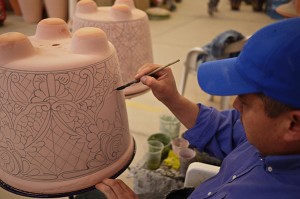 For three centuries a maiolica pottery industry flourished in the Spanish colonial city of Puebla, Mexico. Throughout that time it enjoyed a virtual monopoly in supplying tableware for provincial users of New Spain. It also successfully competed with peninsular Spanish and other European products in more outlying areas in the Caribbean basin. Its colorful tile became a distinguishing hallmark of Puebla architecture. Yet, much of the suggested dating for the various decorative styles that evolved during the course of those centuries has come from finds outside of central Mexico, principally ones scattered from Florida to California along the northern borderlands of the former vice royalty.
For three centuries a maiolica pottery industry flourished in the Spanish colonial city of Puebla, Mexico. Throughout that time it enjoyed a virtual monopoly in supplying tableware for provincial users of New Spain. It also successfully competed with peninsular Spanish and other European products in more outlying areas in the Caribbean basin. Its colorful tile became a distinguishing hallmark of Puebla architecture. Yet, much of the suggested dating for the various decorative styles that evolved during the course of those centuries has come from finds outside of central Mexico, principally ones scattered from Florida to California along the northern borderlands of the former vice royalty.
A more secure and refined chronology derived from stratified materials at or near the original source of the pottery is essential for future research in all sites, whatever side of the international border, where those ceramics are present. With that objective in mind, in the summer of 1981 a search was undertaken within Puebla for undisturbed ceramic deposits suitable for seriation. Preliminary to that search was the determination of the probable locations of the old work yards. That proved to be a relatively easy task, with results of potentially more importance than simply dating of artifacts.
Once the pottery workshop locations were graphically plotted on a map, it was obvious for the first time that a well defined potters’ quarter had existed in Puebla from shadowy beginnings in the late 16th century into the 20th century. Quite likely both unglazed or lead glazed utility vessels and tin glazed tablewares and tiles were made there, though not in the same household factories nor by the same artisans. At a time estimated to be about, the middle of the 19th century (hence the Mexican rather than Spanish period), a second district toward the eastern suburbs began to house small potteries given over to mass production of utilitarian objects.
